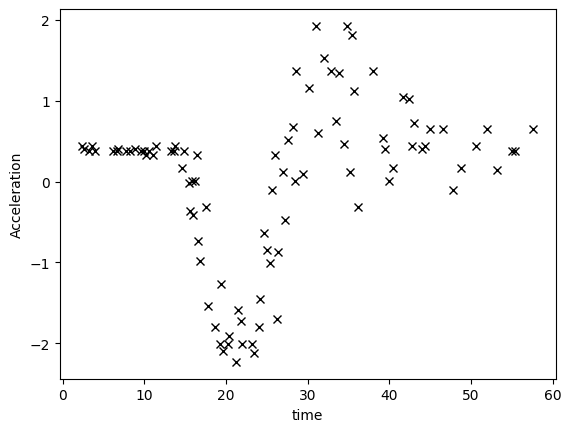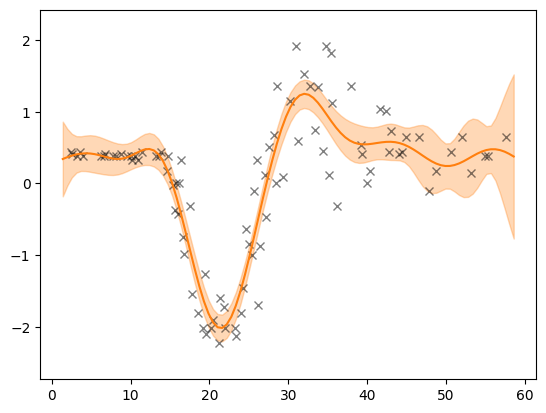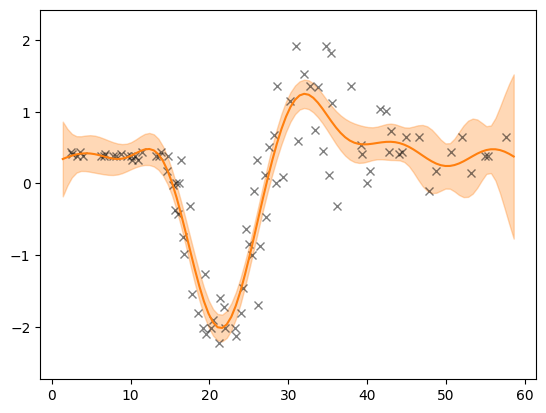Why GPflux is a modern (deep) GP library#
In this notebook we go over some of the features that make GPflux a powerful, deep-learning-style GP library. We demonstrate the out-of-the-box support for monitoring during the course of optimisation, adapting the learning rate, and saving & serving (deep) GP models.
Setting up the dataset and model#
Motorcycle: a toy one-dimensional dataset#
[1]:
import matplotlib.pyplot as plt
import numpy as np
import pandas as pd
import tensorflow as tf
tf.get_logger().setLevel("INFO")
2024-06-20 12:02:50.850470: I tensorflow/tsl/cuda/cudart_stub.cc:28] Could not find cuda drivers on your machine, GPU will not be used.
2024-06-20 12:02:50.882551: I tensorflow/tsl/cuda/cudart_stub.cc:28] Could not find cuda drivers on your machine, GPU will not be used.
2024-06-20 12:02:50.883243: I tensorflow/core/platform/cpu_feature_guard.cc:182] This TensorFlow binary is optimized to use available CPU instructions in performance-critical operations.
To enable the following instructions: AVX2 FMA, in other operations, rebuild TensorFlow with the appropriate compiler flags.
2024-06-20 12:02:51.633163: W tensorflow/compiler/tf2tensorrt/utils/py_utils.cc:38] TF-TRT Warning: Could not find TensorRT
[2]:
def motorcycle_data():
"""
The motorcycle dataset where the targets are normalised to zero mean and unit variance.
Returns a tuple of input features with shape [N, 1] and corresponding targets with shape [N, 1].
"""
df = pd.read_csv("./data/motor.csv", index_col=0)
X, Y = df["times"].values.reshape(-1, 1), df["accel"].values.reshape(-1, 1)
Y = (Y - Y.mean()) / Y.std()
return X, Y
X, Y = motorcycle_data()
plt.plot(X, Y, "kx")
plt.xlabel("time")
plt.ylabel("Acceleration")
[2]:
Text(0, 0.5, 'Acceleration')

Two-layer deep GP#
To keep this notebook focussed we are going to use a predefined deep GP architecture gpflux.architectures.build_constant_input_dim_deep_gp for creating our simple two-layer model.
[3]:
import gpflux
from gpflow.keras import tf_keras
from gpflux.architectures import Config, build_constant_input_dim_deep_gp
from gpflux.models import DeepGP
config = Config(
num_inducing=25, inner_layer_qsqrt_factor=1e-5, likelihood_noise_variance=1e-2, whiten=True
)
deep_gp: DeepGP = build_constant_input_dim_deep_gp(X, num_layers=2, config=config)
Training: mini-batching, callbacks, checkpoints and monitoring#
When training a model, GPflux takes care of minibatching the dataset and accepts a range of callbacks that make it very simple to, for example, modify the learning rate or monitor the optimisation.
[4]:
# From the `DeepGP` model we instantiate a training model which is a `tf.keras.Model`
training_model: tf_keras.Model = deep_gp.as_training_model()
# Following the Keras procedure we need to compile and pass a optimizer,
# before fitting the model to data
training_model.compile(optimizer=tf_keras.optimizers.Adam(learning_rate=0.01))
callbacks = [
# Create callback that reduces the learning rate every time the ELBO plateaus
tf_keras.callbacks.ReduceLROnPlateau("loss", factor=0.95, patience=3, min_lr=1e-6, verbose=0),
# Create a callback that writes logs (e.g., hyperparameters, KLs, etc.) to TensorBoard
gpflux.callbacks.TensorBoard(),
# Create a callback that saves the model's weights
tf_keras.callbacks.ModelCheckpoint(filepath="ckpts/", save_weights_only=True, verbose=0),
]
history = training_model.fit(
{"inputs": X, "targets": Y},
batch_size=12,
epochs=200,
callbacks=callbacks,
verbose=0,
)
WARNING:tensorflow:Model failed to serialize as JSON. Ignoring... Cannot pickle Tensor -- its value is not known statically: Tensor("gp_0/Identity:0", shape=(), dtype=float64).
2024-06-20 12:02:56.236347: I tensorflow/tsl/profiler/lib/profiler_session.cc:104] Profiler session initializing.
2024-06-20 12:02:56.236375: I tensorflow/tsl/profiler/lib/profiler_session.cc:119] Profiler session started.
2024-06-20 12:02:56.236802: I tensorflow/tsl/profiler/lib/profiler_session.cc:131] Profiler session tear down.
2024-06-20 12:03:00.270366: I tensorflow/tsl/profiler/lib/profiler_session.cc:104] Profiler session initializing.
2024-06-20 12:03:00.270394: I tensorflow/tsl/profiler/lib/profiler_session.cc:119] Profiler session started.
2024-06-20 12:03:00.274677: I tensorflow/tsl/profiler/lib/profiler_session.cc:70] Profiler session collecting data.
2024-06-20 12:03:00.276101: I tensorflow/tsl/profiler/lib/profiler_session.cc:131] Profiler session tear down.
2024-06-20 12:03:00.276350: I tensorflow/tsl/profiler/rpc/client/save_profile.cc:144] Collecting XSpace to repository: logs/plugins/profile/2024_06_20_12_03_00/fv-az1113-528.xplane.pb
The call to fit() returns a history object that contains information like the loss and the learning rate over the course of optimisation.
[5]:
fig, (ax1, ax2) = plt.subplots(1, 2, figsize=(12, 3))
ax1.plot(history.history["loss"])
ax1.set_xlabel("Iteration")
ax1.set_ylabel("Objective = neg. ELBO")
ax2.plot(history.history["lr"])
ax2.set_xlabel("Iteration")
ax2.set_ylabel("Learning rate")
[5]:
Text(0, 0.5, 'Learning rate')

More insightful, however, are the TensorBoard logs. They contain the objective and hyperparameters over the course of optimisation. This can be very handy to find out why things work or don’t :D. The logs can be viewed in TensorBoard by running in the command line
$ tensorboard --logdir logs
[6]:
def plot(model, X, Y, ax=None):
if ax is None:
fig, ax = plt.subplots()
x_margin = 1.0
N_test = 100
X_test = np.linspace(X.min() - x_margin, X.max() + x_margin, N_test).reshape(-1, 1)
out = model(X_test)
mu = out.f_mean.numpy().squeeze()
var = out.f_var.numpy().squeeze()
X_test = X_test.squeeze()
lower = mu - 2 * np.sqrt(var)
upper = mu + 2 * np.sqrt(var)
ax.set_ylim(Y.min() - 0.5, Y.max() + 0.5)
ax.plot(X, Y, "kx", alpha=0.5)
ax.plot(X_test, mu, "C1")
ax.fill_between(X_test, lower, upper, color="C1", alpha=0.3)
prediction_model = deep_gp.as_prediction_model()
plot(prediction_model, X, Y)

Post-training: saving, loading, and serving the model#
We can store the weights and reload them afterwards.
[7]:
prediction_model.save_weights("weights")
[8]:
prediction_model_new = build_constant_input_dim_deep_gp(
X, num_layers=2, config=config
).as_prediction_model()
prediction_model_new.load_weights("weights")
[8]:
<tensorflow.python.checkpoint.checkpoint.CheckpointLoadStatus at 0x7fd9e251de80>
[9]:
plot(prediction_model_new, X, Y)

Indeed, this prediction corresponds to the one of the original model.